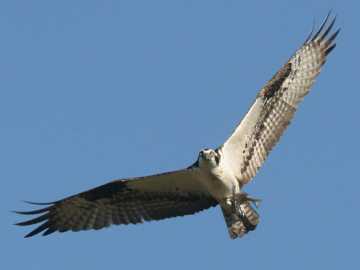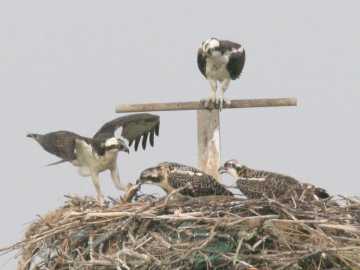

PHOTO COURTESY OF GARRY KESSLER
An osprey carries a fish in its deadly talons after plunging head- and feet-first into the water to capture it. This fish-eating raptor with a 5-foot wingspan has spiked scales on the bottom of its feet that help it hang on to its slippery prey. During the nesting season, the male osprey typically supplies all the food for himself, his mate, and their young, bringing 3 to 10 fish each day.
April 11, 2008, Page 13
NATURE NOTES
By Annie Reid
Westborough Community Land Trust
Ospreys return to Mill Pond
Spring is making a slow, cool start in Westborough this year, but early April brings signs that it’s really here.
Furry pussy willows glisten at the edges of wetlands, and skunk cabbage pokes up in our swamps. Redwing blackbirds have arrived in our cattail marshes, advertising their territory with their distinctive song. Red maple treetops are in bloom. Vernal pool amphibians had their “big night” of breeding on March 31, and wood frogs quacked in our vernal pools for several days afterward.
With lengthening days and robins on our lawns comes a question: Will the ospreys return to nest at Mill Pond again this year? For a dozen years – since 1996 – a pair of ospreys (Pandion haliaetus) has nested there, after wintering in South America. Westborough has had the distinction and privilege of hosting this pair of inland nesting ospreys, a rare sight in our area. Most ospreys in this part of New England nest along the coast, including Cape Cod and the islands.
So far things look promising. By April first, one osprey was back, probably the male. As with many birds, male ospreys return to the breeding grounds before the females. Last weekend two ospreys were back.
You can watch for them from Osprey Point at the Headwaters Conservation Area, a half-mile walk from the Andrews Street entrance. Look out over the dead trees in the water, ideally with binoculars.
Ospreys are raptors – birds of prey. But they don’t take just any prey. Also called fish hawks, these raptors hunt and eat live fish. Their focus on fish is so exclusive that small birds (such as common grackles, tree swallows, European starlings, and house sparrows) sometimes build their own nests inside osprey nests, unconcerned and undisturbed by their fish-eating landlords.
Ospreys typically hunt from the air, often hovering over the water to spot a target and then plunging head-and feet-first into the water to seize it in their deadly talons. Their powerful wings allow them to fly up out of the water, burdened with their prey. Sometimes they also perch on a branch over water to watch for fish.
What brings ospreys to Westborough’s Mill Pond? The 380-acre pond is a flood control reservoir, created in 1968 when the Nichols Dam was built near the headwaters of the Assabet River. The spreading waters killed many trees, giving the pond the nickname Stump Pond.
The pond was very much like ponds that beavers had routinely created throughout New England in bygone days – a large, shallow pond filled with standing dead trees. From an osprey’s point of view, its shallow waters were good for fishing from the air and its dead trees were suitable for nesting over water, safe from land predators such as snakes and raccoons.

PHOTO COURTESY OF GARRY KESSLER
Cape Cod nesting ospreys feed a fish to their young on a nesting platform at the Cape Cod Museum of Natural History, Brewster. A similar nesting platform was installed in Westborough’s Mill Pond a year ago to provide Westborough’s osprey pair with a new nesting site when the dead tree now holding their nest falls down.
Beaver disappeared from Massachusetts around 1750, due to trapping and clearing of land for farming, and so eventually did their ponds. Over time, the woods reclaimed beaver ponds, turning them into red maple swamps crowded with bushes and trees. (Beaver are now making a comeback, but extensive human development may limit their activities.)
In short, in Westborough the ospreys benefited from a human-made environment that happened to resemble an attractive natural one that had grown scarce due to human activity.
Today, time and weather have taken down most of the standing dead trees in Mill Pond. (The stumps remain underwater, as boaters will tell you.) The great blue herons that nested in them for 30 years have finally moved elsewhere. Fortunately for the ospreys, the tree with their huge, ball-like nest remains, but its days are numbered.
Concerned that the ospreys might need to nest elsewhere in the near future, people have given the ospreys a new alternative. About a year ago, in February 2007, a team of volunteers from the Organization for the Assabet River (OAR) and employees from Massachusetts Fish and Wildlife ventured onto the ice and set up a 16-foot utility pole with a nesting platform on top. Such pole-and-platform arrangements have been widely successful in attracting nesting ospreys in coastal locations. (To see photos of the pole installation, check the OAR website: http://www.assabetriver.org/riverpics/ospreyplatform2007/)
So far this year, the osprey pair has been frequenting their old nest, but at least one has also spent time on the platform. Cleary they know it’s there.
According to Dave Griffin, OAR president and long-time observer and photographer of Mill Pond’s ospreys, the ospreys may not have successfully raised young in the past two years. One of the parents, and perhaps both, may now be different from the pair that originally nested here for many years. (To view Dave’s osprey photos, go to: http://dmg-photography.com )
The theme of humans both taking and giving has been a key part of the outlook for ospreys on both a local and a worldwide scale over the past half-century.
Along with other raptors such as bald eagles and peregrine falcons, ospreys had nearly disappeared from our area by the late 1960s due to poisoning from pesticides that persist in the environment, especially DDT. As creature eats creature, toxins that don’t easily break down get passed along the food chain and eventually build up in the bodies of the last to feed – the top predators such as these raptors
Not only did these raptors sicken and die, but they also failed to reproduce. Why? Among other things, as a result of the toxins, their eggshells were too thin to protect their eggs.
The vanishing raptors helped to alert people to the dangers of DDT, which can also harm humans. These birds warned humans of unnoticed dangers in the environment, much as canaries that miners brought into coal mines once warned of dangerous gases by dying. Most uses of DDT were banned in the U.S. in 1972, and ospreys and other raptors have been increasing in number since then. Human efforts on their behalf, such as installing nesting platforms for ospreys, have helped the recovery.
If you’re interested in raptors, don’t miss the special presentation featuring live raptors, “Raptors’ Struggle to Survive” with Larry Keating, this Saturday morning, April 12, 10-11 a.m., Knights of Columbus Hall, 17 Willow Street.